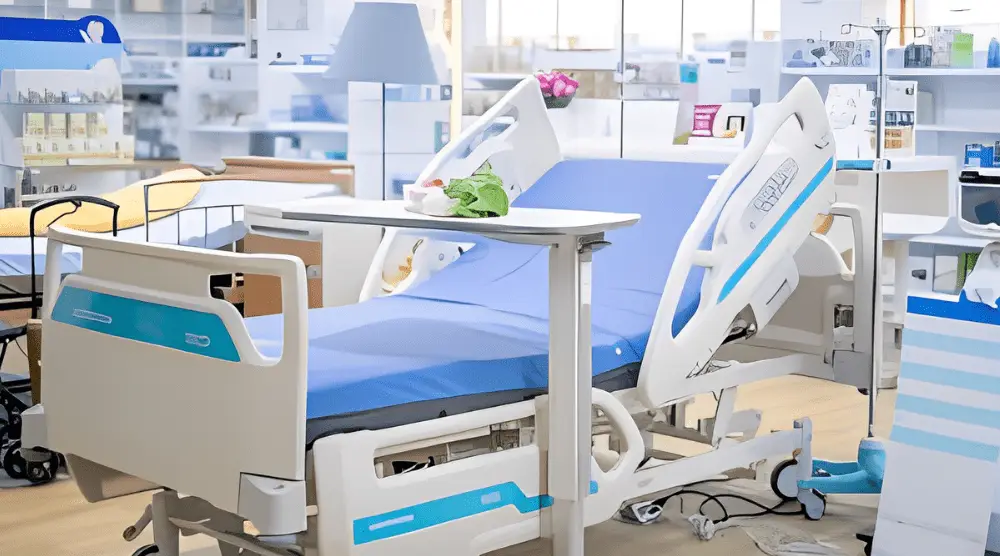In-home hospital beds are essential for individuals who require long-term care, are recovering from surgery, or have chronic health conditions that necessitate extended bed rest. These beds provide the necessary support, comfort, and safety that traditional beds cannot offer, making them a crucial part of home healthcare. This article will explore the types, benefits, and key considerations when choosing an in-home hospital bed, along with answers to common questions.
What Are In-Home Hospital Beds?
In-home hospital beds are specialized beds designed to meet the medical and comfort needs of patients who need to be cared for at home. Unlike standard beds, they offer adjustable features that allow the bed’s position to be customized for the patient’s needs. These beds are similar to those found in hospitals, but they are designed to be used in a home environment.
Types of In-Home Hospital Beds
- Manual Hospital Beds
Manual hospital beds require physical effort to adjust the bed’s position. They typically have a crank system that allows the head, foot, and height of the bed to be adjusted. While these beds are the most affordable option, they may not be suitable for patients or caregivers who lack the strength or ability to operate them. - Semi-Electric Hospital Beds
Semi-electric hospital beds combine manual and electric features. The head and foot positions can be adjusted electronically, while the bed height is adjusted manually. These beds offer a balance between convenience and cost, making them a popular choice for many home care situations. - Fully Electric Hospital Beds
Fully electric hospital beds offer complete adjustability via a remote control. The head, foot, and bed height can all be adjusted without any manual effort, providing maximum convenience for both the patient and the caregiver. These beds are ideal for patients who require frequent repositioning or who have limited mobility. - Bariatric Hospital Beds
Bariatric hospital beds are designed to accommodate larger patients, with a higher weight capacity and a wider frame. These beds are built to provide additional support and stability, ensuring the safety and comfort of bariatric patients. - Low Hospital Beds
Low hospital beds are designed to reduce the risk of falls by positioning the bed closer to the floor. They are especially useful for patients who are at a high risk of falling out of bed. These beds can be adjusted to various heights, making them versatile for different care needs.
Benefits of In-Home Hospital Beds
- Enhanced Patient Comfort
The ability to adjust the bed’s position allows patients to find the most comfortable setting for resting or sleeping. This is particularly important for patients who spend long periods in bed, as it helps to prevent discomfort, bedsores, and other complications associated with immobility. - Improved Safety
In-home hospital beds are equipped with safety features such as side rails, which help prevent falls and provide support when the patient is getting in and out of bed. These beds also allow for easy adjustment to the height, reducing the risk of injury during transfers. - Ease of Caregiving
Adjustable hospital beds make it easier for caregivers to perform tasks such as bathing, feeding, and repositioning the patient. The bed can be raised or lowered to a comfortable working height, reducing the physical strain on the caregiver. - Support for Medical Needs
In-home hospital beds are designed to accommodate a wide range of medical conditions. For example, patients with respiratory issues may benefit from sleeping in an elevated position, while those with circulatory problems may need their legs raised. The adjustable features of hospital beds make it possible to meet these specific needs. - Promotes Independence
Some patients are able to operate the bed’s controls on their own, allowing them to adjust their position without assistance. This promotes a sense of independence and can improve the patient’s overall well-being.
Key Considerations When Choosing an In-Home Hospital Bed
- Patient’s Medical Needs
Consider the specific medical conditions and mobility limitations of the patient when selecting a hospital bed. For example, a patient with severe mobility issues might require a fully electric bed with additional safety features. - Space Availability
Measure the space where the bed will be placed to ensure it fits comfortably. Hospital beds are larger than regular beds, so it’s important to account for the additional space needed for the bed itself, as well as for caregivers to move around the bed. - Budget
Hospital beds vary in price depending on their features and build quality. While manual beds are the most affordable, fully electric beds offer the most convenience and comfort. Consider your budget and the patient’s needs when making a decision. - Ease of Use
The bed should be easy to operate for both the patient and the caregiver. Fully electric beds with intuitive remote controls are the easiest to use, but if the patient can manage some manual adjustments, a semi-electric bed might be a more cost-effective option. - Mattress Compatibility
Ensure that the bed is compatible with a medical-grade mattress. The right mattress is essential for preventing bedsores and providing the necessary support. Pressure-relief mattresses or memory foam options are often recommended for use with hospital beds. - Insurance Coverage
Check with your insurance provider to see if the cost of the hospital bed is covered. Many insurance plans will cover part or all of the cost if the bed is deemed medically necessary, but a prescription from a healthcare provider may be required.
Maintenance and Care for In-Home Hospital Beds
- Regular Cleaning
Clean the bed frame, mattress, and controls regularly to prevent the buildup of germs and bacteria. Use appropriate cleaning solutions that won’t damage the bed’s materials. - Inspection and Repairs
Periodically inspect the bed for any signs of wear and tear, especially in the motor and electrical components if it’s an electric bed. Address any issues promptly to ensure the bed remains safe and functional. - Lubrication
Keep the bed’s moving parts well-lubricated to ensure smooth operation. This is particularly important for manual and semi-electric beds. - Mattress Care
Rotate and clean the mattress regularly to prevent wear and maintain hygiene. If the mattress shows signs of damage or wear, consider replacing it to maintain comfort and support.
FAQs About In-Home Hospital Beds
- What is the difference between a manual and a fully electric hospital bed?
A manual hospital bed requires the caregiver to manually adjust the bed’s position using a crank system, while a fully electric hospital bed allows for all adjustments to be made electronically using a remote control. Fully electric beds are more convenient, especially for patients who need frequent repositioning. - Can in-home hospital beds be rented instead of purchased?
Yes, many medical supply companies offer hospital bed rentals. Renting can be a cost-effective option if the bed is needed for a short period, such as during recovery from surgery. However, for long-term use, purchasing a bed may be more economical in the long run. - Are in-home hospital beds covered by insurance?
In many cases, insurance will cover the cost of an in-home hospital bed if it is deemed medically necessary. The coverage may vary depending on the insurance provider and the specific medical condition. A prescription from a healthcare provider is typically required to qualify for coverage.
What kind of mattress should be used with an in-home hospital bed?
It is recommended to use a medical-grade mattress with an in-home hospital bed, such as a pressure-relief or memory foam mattress. These mattresses are designed to prevent bedsores and provide adequate support for patients who spend long periods in bed.https://www.epachois.com/



